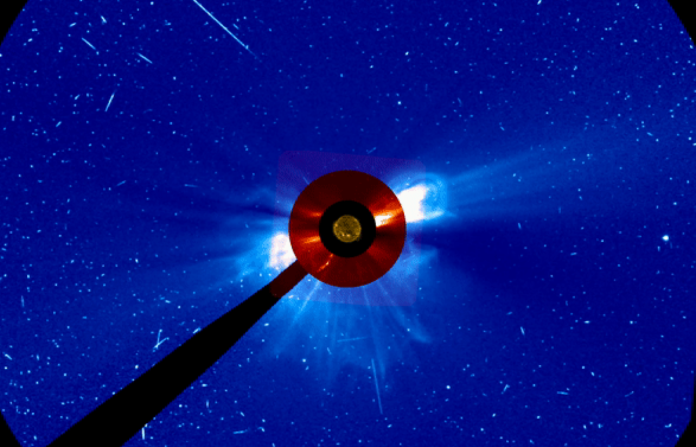Astronomers have detected a solar eruption that struck the Earth , the moon and Mars simultaneously for the first time, an advance that could help better understand the sun’s outbursts and protect astronauts in the future. The solar storm, which erupted on 28 October 2021, was spread over such a wide area that Mars and Earth – while on the opposite sides of the sun and around 250 million km apart – received an influx of energetic particles from the sun. This is the first time that a solar event was measured simultaneously on the surfaces of Earth, moon and Mars, according to a new study published on Wednesday in the journal Geographical Research Letters . Researchers assessed readings of the solar event detected by an international fleet of spacecraft, including Nasa’s Curiosity Mars rover, China’s Chang’e-4 Moon lander and the European Space Agency’s ExoMars Trace Gas Orbiter (TGO). Scientists said the solar event was a rare ‘ground level enhancement’ during which energetic particles from the sun passed through the magnetic bubble that surrounds Earth and protects the planet from such solar outbursts. Since the moon and Mars do not have their own magnetic fields, the particles from the sun could easily reach their surfaces and interact with their soil to generate secondary radiation. Understanding such solar events are important, according to scientists, as the moon and Mars are the focus of future human exploration. Exposure to any radiation dose above 700 milligray – the unit for the absorption of radiation – can induce radiation sickness in astronauts. This leads to the destruction of the bone marrow in astronauts, resulting in symptoms such as infection and internal bleeding. Astronauts exposed to over 10 gray are extremely unlikely to survive more than two weeks, scientists said. In comparison, the radiation dose in lunar orbit from the October 2021 solar event, as measured by Nasa’s LRO, was only about 31 milligray. ‘Our calculations of the past ground level enhancement events show that on average one event every 5.5 years may have exceeded the safe dose level on the Moon if no radiation protection had been provided. Understanding these events is crucial for future crewed missions to the surface of the Moon,’ study co-author Jingnan Guo said. The research also shed light on the protection offered from such solar outbursts by Mars’ thin atmosphere. Measurements made by ExoMars TGO and by the Curiosity rover of the October 2021 event suggests a radiation dose of 9 milligray reached Mars’ orbit, which was 30 times more than the 0.3 milligray detected on the Red Planet’s surface. The new results may add to more knowledge for the better design of protective space suits for astronauts. ‘Space radiation can create a real danger to our exploration throughout the Solar System. Measurements of high-level radiation events by robotic missions is critical to prepare for long-duration crewed missions. Thanks to data from missions like ExoMars TGO we can prepare for how best to protect our human explorers,’ TGO project scientist Colin Wilson said.
Massive solar storm strikes Earth, Moon and Mars together for first time in history
Sourceindependent.co.uk
RELATED ARTICLES


